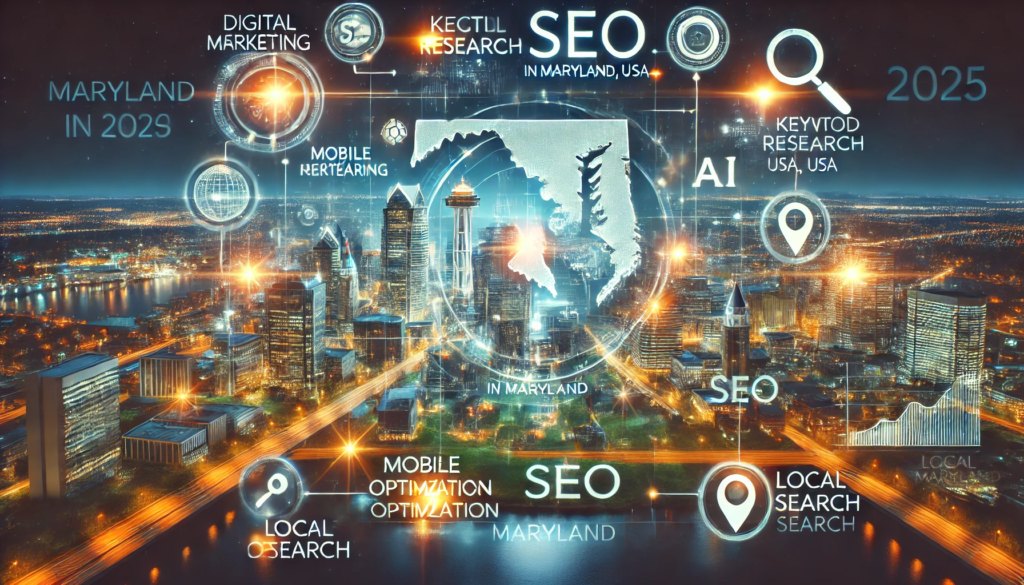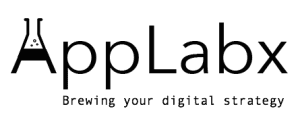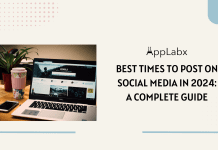Key Takeaways
- Local SEO and AI-driven search are essential for Maryland businesses to rank higher in 2025—optimize for Google Business Profile and voice search.
- Content marketing, E-E-A-T, and video SEO will dominate—focus on high-quality, user-centric, and AI-optimized content to boost visibility.
- Technical SEO, mobile-first indexing, and structured data will be key—ensure fast-loading, well-structured websites for better rankings.
In today’s digital landscape, having a strong online presence is no longer optional—it is a necessity.
Businesses across Maryland, from Baltimore to Annapolis and beyond, are constantly competing for visibility in search engine results.
Whether you own a small local business, run a mid-sized company, or manage a large enterprise, search engine optimization (SEO) is the key to staying ahead of the competition.
With SEO evolving rapidly, keeping up with the latest strategies and best practices is essential to ensure long-term success.

As we enter 2025, the SEO landscape is more dynamic than ever.
Google’s algorithm updates, the increasing role of artificial intelligence (AI), the dominance of mobile search, and the growing importance of user experience (UX) have reshaped how businesses approach search engine rankings.
Maryland businesses that want to thrive in the digital world must adapt to these changes, leveraging local SEO, high-quality content, and technical optimization to improve their visibility.
This guide provides a comprehensive overview of everything you need to know about SEO in Maryland in 2025.
Whether you are a business owner, a marketer, or an SEO professional, you will find valuable insights into the latest trends, best practices, and strategies tailored specifically for businesses operating in Maryland.
Why SEO Matters for Maryland Businesses in 2025
With nearly every consumer relying on search engines to find products, services, and local businesses, SEO has become one of the most powerful marketing tools. Here are some key reasons why SEO is essential for Maryland businesses:
1. Increased Online Competition
Maryland has a thriving business environment, with industries ranging from healthcare and technology to tourism and retail. With more businesses investing in digital marketing, simply having a website is not enough. SEO ensures that your business stands out in local search results, attracting potential customers before they turn to your competitors.
2. Shift in Consumer Behavior
Today’s consumers expect fast, relevant, and personalized search results. They no longer scroll through multiple pages of Google results; instead, they rely on the top-ranking businesses that appear on the first page. SEO helps ensure that your website ranks higher for the keywords your audience is searching for, making it easier for them to find you.
3. Local SEO and Hyper-Targeted Searches
Local SEO has become a game-changer for businesses targeting customers within a specific geographic area. In Maryland, where customers search for businesses based on location (e.g., “best coffee shop in Baltimore” or “plumber near me in Annapolis”), optimizing for local SEO ensures that your business appears in relevant local search queries. This is particularly important for businesses with a physical storefront or those offering location-based services.
4. Google’s Evolving Algorithms
Search engines, especially Google, are constantly refining their ranking algorithms to provide users with the best search experience. Recent updates focus on elements such as user intent, content quality, mobile-friendliness, and Core Web Vitals. If your website does not align with these factors, you risk losing valuable organic traffic. Understanding and implementing SEO best practices tailored to 2025’s algorithm updates is crucial for long-term success.
5. The Growing Role of AI and Automation
Artificial intelligence is transforming how search engines rank websites. Features such as Google’s AI-driven Search Generative Experience (SGE) and machine-learning algorithms are influencing search rankings in ways that were unheard of just a few years ago. SEO strategies in 2025 will require businesses to optimize their content for AI-driven search queries, improving semantic search relevance and user engagement metrics.
The State of SEO in Maryland: What’s Unique?
Maryland is a diverse state with unique business dynamics that impact SEO strategies. Unlike national SEO, which focuses on broad, high-competition keywords, Maryland-based businesses need a localized approach to attract customers within the state.
- High Local Competition: Cities like Baltimore, Rockville, and Columbia are highly competitive markets where businesses need a strong SEO strategy to stand out. Optimizing for hyper-local keywords, Google My Business (GMB) listings, and customer reviews is crucial.
- Tourism-Driven SEO Needs: Maryland is home to tourist hotspots such as the National Harbor, Ocean City, and historical landmarks in Annapolis. Businesses in the tourism, hospitality, and restaurant industries must focus on mobile SEO, local citations, and voice search optimization.
- The Impact of Government and Tech Hubs: Maryland hosts major government agencies and tech companies, particularly in areas like Bethesda and Silver Spring. B2B companies targeting these sectors must incorporate thought leadership content, LinkedIn SEO, and enterprise-level SEO strategies.
What You Will Learn in This Guide
This guide will walk you through the core aspects of SEO in Maryland, including:
- The latest SEO trends and algorithm updates affecting Maryland businesses in 2025.
- How to conduct effective keyword research tailored for Maryland audiences.
- On-page SEO techniques to improve content visibility.
- Off-page SEO strategies, including link-building and local citations.
- Technical SEO best practices, such as optimizing for Core Web Vitals and mobile search.
- Local SEO tactics for ranking in Google’s local pack and maps.
- How to measure and improve SEO performance with analytics tools.
- The future of SEO beyond 2025 and how Maryland businesses can stay ahead.
Final Thoughts
As Maryland businesses continue to navigate the evolving digital landscape, a well-executed SEO strategy will be the key to online success. Whether you are a small local business in Annapolis, a tech startup in Bethesda, or a hospitality brand in Ocean City, implementing the right SEO tactics will help you attract more customers, increase website traffic, and drive conversions.
This guide will serve as your roadmap to mastering SEO in Maryland in 2025. By the end of it, you will have the knowledge and strategies needed to dominate search rankings and grow your business online. Let’s dive into the world of SEO and explore the best practices that will shape digital marketing success in Maryland this year and beyond.
But, before we venture further, we like to share who we are and what we do.
About AppLabx
From developing a solid marketing plan to creating compelling content, optimizing for search engines, leveraging social media, and utilizing paid advertising, AppLabx offers a comprehensive suite of digital marketing services designed to drive growth and profitability for your business.
AppLabx is well known for helping companies and startups use SEO to drive web traffic to their websites and web apps.
At AppLabx, we understand that no two businesses are alike. That’s why we take a personalized approach to every project, working closely with our clients to understand their unique needs and goals, and developing customized strategies to help them achieve success.
If you need a digital consultation, then send in an inquiry here.
AppLabx SEO Agency: The Top SEO Agency in Maryland for 2025
In the ever-evolving world of digital marketing and search engine optimization, businesses in Maryland need an expert partner to stay ahead of the competition. AppLabx SEO Agency stands out as the leading SEO agency in Maryland for 2025, helping businesses achieve higher rankings, increased traffic, and more conversions with cutting-edge SEO strategies.
Why Choose AppLabx SEO Agency in Maryland?
AppLabx isn’t just another SEO agency—it is a results-driven powerhouse that specializes in tailored, data-driven SEO strategies to help businesses dominate the search engine results pages (SERPs). Here’s why Maryland businesses trust AppLabx for their SEO needs:
- Proven Track Record of Success
- Helped hundreds of Maryland businesses achieve top rankings in Google search results.
- Increased organic traffic and lead generation for businesses across industries.
- Case studies showcase significant improvements in rankings within months.
- Cutting-Edge SEO Strategies
- Uses AI-driven SEO techniques to adapt to Google’s evolving algorithms.
- Implements voice search optimization, structured data, and video SEO to maximize visibility.
- Specializes in hyper-local SEO, ensuring Maryland businesses rank high in “near me” searches.
- Custom-Tailored SEO Solutions
- No one-size-fits-all approach—strategies are customized based on business goals and competition.
- Industry-specific SEO expertise across e-commerce, healthcare, real estate, law firms, and more.
- Comprehensive SEO audits to identify strengths, weaknesses, and opportunities.
AppLabx’s Core SEO Services for Maryland Businesses
AppLabx provides a full range of SEO services designed to help businesses succeed in Maryland’s competitive digital market.
- Local SEO & Google Business Profile Optimization
- Enhances Google Business Profile listings for higher visibility in local searches.
- Builds strong local citations and backlinks to improve credibility.
- Optimizes for hyper-local search terms to attract Maryland customers.
- On-Page SEO & Content Optimization
- Conducts in-depth keyword research to target high-intent search queries.
- Optimizes web pages with SEO-friendly titles, meta descriptions, and headers.
- Creates high-quality, engaging, and AI-optimized content that ranks.
- Technical SEO & Website Performance Optimization
- Ensures websites are fast, mobile-friendly, and technically sound.
- Implements structured data (schema markup) to improve search visibility.
- Fixes broken links, duplicate content, and crawl errors to boost rankings.
- Link-Building & Off-Page SEO
- Builds high-authority backlinks from reputable Maryland websites.
- Engages in guest blogging and PR outreach to increase domain authority.
- Implements a content-driven link-building strategy for long-term success.
- E-E-A-T & AI-Optimized Content Marketing
- Focuses on Experience, Expertise, Authoritativeness, and Trustworthiness to meet Google’s quality guidelines.
- Uses AI-powered content strategies to maximize organic visibility.
- Creates blog posts, videos, and infographics optimized for search intent.
Get Ahead in 2025 with AppLabx: Maryland’s Leading SEO Agency
SEO in 2025 is more competitive than ever, and only the best strategies will ensure long-term success. Whether you’re a small local business or an established enterprise, AppLabx provides the expertise, tools, and strategies to help you dominate search rankings, attract targeted traffic, and grow your business.
Ready to Elevate Your SEO Strategy? Contact AppLabx Today!
Partner with Maryland’s top SEO agency and take your business to new heights in 2025. Book a free SEO consultation with AppLabx today and start your journey to higher rankings, better traffic, and more revenue.
A Complete Guide to SEO in Maryland, USA in 2025
- Understanding SEO in 2025
- Key SEO Strategies for Maryland Businesses
- Local SEO for Maryland Businesses
- Content Marketing for Maryland SEO
- Measuring and Improving SEO Performance
- Future of SEO in Maryland (Beyond 2025)
1. Understanding SEO in 2025
Search engine optimization (SEO) is an ever-evolving digital marketing strategy, and in 2025, it continues to shape how businesses in Maryland reach their target audiences. As Google refines its algorithms and user behavior shifts, Maryland businesses must adapt to the latest SEO trends to maintain a competitive edge.
This section explores the core elements of SEO in Maryland, including major changes in search algorithms, the growing importance of local SEO, and how businesses can leverage new technologies to improve their rankings.
How SEO Has Changed in 2025
The SEO landscape is significantly different from what it was a few years ago. Several new trends and updates are redefining how search engines rank websites.
1. Google’s Latest Algorithm Updates
Google frequently updates its search algorithms to improve user experience and relevance. In 2025, some key changes include:
- AI-Driven Search Results: Google’s Search Generative Experience (SGE) and AI-powered search features are prioritizing high-quality, authoritative content. Websites that provide in-depth, well-structured information rank higher.
- Emphasis on User Experience (UX): Factors such as Core Web Vitals, page speed, and interactivity play a crucial role in rankings. Websites with slow loading speeds or poor mobile responsiveness see a decline in search visibility.
- E-E-A-T (Experience, Expertise, Authoritativeness, Trustworthiness): Google places greater importance on content that demonstrates expertise and credibility. Maryland businesses must ensure that their content aligns with industry expertise and builds trust with their audience.
Example:
A Baltimore-based law firm optimizing for “best personal injury attorney in Maryland” will need to create well-researched, authoritative content, including legal guides, case studies, and expert commentary, to rank higher in search results.
2. AI and Machine Learning in Search Rankings
Artificial intelligence (AI) is revolutionizing SEO by influencing search rankings and content optimization.
- AI-Generated Snippets: Google’s AI-driven search results provide direct answers to queries. Businesses must optimize content to appear in featured snippets and AI-generated summaries.
- Voice Search Optimization: With smart speakers and mobile voice assistants becoming more common, optimizing for natural language queries (e.g., “Where can I find the best seafood in Annapolis?”) is essential.
- Personalized Search Results: AI-driven search results consider user history, location, and browsing behavior. Businesses need to deliver hyper-relevant content based on user intent.
Example:
A restaurant in Ocean City targeting “best crab cakes near me” should structure its content with FAQs, customer reviews, and locally relevant keywords to optimize for both text and voice searches.
3. The Growing Importance of Mobile-First Indexing
As mobile traffic continues to dominate, Google prioritizes mobile-friendly websites in its rankings. Key considerations include:
- Responsive Design: Websites must be fully optimized for mobile devices with fast loading times and easy navigation.
- Mobile UX Enhancements: Features like click-to-call buttons, fast checkout processes, and simplified menus improve user experience.
- Google’s Core Web Vitals: Websites must meet Google’s performance metrics, including First Input Delay (FID), Largest Contentful Paint (LCP), and Cumulative Layout Shift (CLS).
Example:
A Rockville-based e-commerce store selling handmade jewelry should ensure its product pages load quickly on mobile devices, feature high-quality images, and include a streamlined checkout process to prevent cart abandonment.
Local vs. National SEO: What Matters for Maryland Businesses?
For businesses operating in Maryland, local SEO is often more valuable than national SEO. While national SEO focuses on broad, high-competition keywords, local SEO emphasizes visibility within specific geographic areas.
1. Why Local SEO Matters in Maryland
- Maryland’s Competitive Business Landscape: Cities like Baltimore, Bethesda, and Columbia have dense markets where businesses must optimize for local search to stand out.
- High Volume of Local Searches: Many consumers search for businesses near them, making local SEO crucial for attracting foot traffic and local customers.
- Google My Business (GMB) and Local Pack Rankings: A well-optimized GMB listing can help businesses rank in the “Local Pack” (the top three business listings shown in Google Maps results).
Example:
A dental clinic in Towson optimizing for “best family dentist in Towson” must ensure that its GMB profile is updated with accurate contact details, office hours, and customer reviews to appear in local search results.
2. Key Differences Between Local and National SEO
| Factor | Local SEO (Maryland) | National SEO |
|---|---|---|
| Target Audience | Focuses on nearby customers | Targets customers across the country |
| Keyword Strategy | Includes geo-targeted keywords (e.g., “plumber in Annapolis”) | Uses broader keywords (e.g., “best plumbing services”) |
| Google My Business | Essential for rankings in Google Maps | Less relevant for national brands |
| Backlink Strategy | Emphasizes local citations and partnerships | Prioritizes high-authority, national backlinks |
3. How to Optimize for Local SEO in Maryland
To rank well in Maryland’s local search results, businesses should:
- Claim and Optimize Google My Business: Keep business details accurate, upload high-quality images, and encourage customer reviews.
- Build Local Citations: List the business on Maryland-based directories such as the Maryland Chamber of Commerce, Yelp Maryland, and local business associations.
- Use Location-Specific Keywords: Incorporate city and neighborhood names in page titles, meta descriptions, and content.
- Encourage Customer Reviews: Positive reviews on Google and Yelp enhance credibility and improve local rankings.
Example:
A fitness center in Silver Spring optimizing for “top-rated gym in Silver Spring” should include geo-targeted keywords in its content, create location-based landing pages, and encourage members to leave positive reviews.
The Role of Backlinks and Citations in Maryland SEO
Backlinks and citations play a crucial role in SEO success. They signal to Google that a website is authoritative and relevant.
1. Importance of Backlinks in SEO Rankings
- Boosts Domain Authority: High-quality backlinks from reputable Maryland websites improve search rankings.
- Enhances Local Credibility: Links from Maryland newspapers, blogs, and business directories establish trust.
- Drives Referral Traffic: Backlinks from high-traffic websites can generate additional visitors.
2. How to Build Local Backlinks in Maryland
- Guest Posting: Contribute articles to Maryland-based publications and blogs.
- Business Partnerships: Collaborate with local businesses for mutual backlinking opportunities.
- Sponsorships and Community Engagement: Sponsor local events or partner with nonprofits to earn backlinks from their websites.
Example:
A landscaping company in Frederick can write guest blog posts for local home improvement websites or partner with real estate agencies for referral links.
Final Thoughts
SEO in Maryland in 2025 is a complex but necessary strategy for businesses looking to thrive in an increasingly digital world. With the rise of AI-driven search, mobile-first indexing, and local SEO, businesses must adapt to new trends and leverage region-specific tactics to improve their search visibility.
By optimizing for local search, building authoritative backlinks, and focusing on user experience, Maryland businesses can drive more organic traffic, attract local customers, and stay ahead of the competition. In the next section, we will explore the key SEO strategies businesses should implement to dominate Maryland’s digital marketplace.
2. Key SEO Strategies for Maryland Businesses
For businesses in Maryland, staying ahead in the digital landscape requires a well-structured and adaptive SEO strategy. With evolving search algorithms, increased competition, and changing user behavior, businesses must implement a combination of on-page, off-page, local, and technical SEO strategies to dominate search rankings.
This section explores the most effective SEO strategies for Maryland businesses in 2025, providing actionable insights and real-world examples to help optimize websites for better visibility and customer engagement.
1. Keyword Research for Maryland SEO
Keyword research remains the foundation of any successful SEO strategy. Identifying the right keywords ensures that businesses rank for relevant searches performed by their target audience.
1.1 Importance of Geo-Targeted Keywords
- Maryland businesses must focus on localized keywords to attract customers within their service areas.
- Long-tail keywords (e.g., “best seafood restaurant in Baltimore”) are more effective than broad terms (e.g., “seafood restaurant”).
- Including Maryland-specific terms, such as city names, neighborhoods, and landmarks, can improve search rankings.
Example:
A law firm in Annapolis should target keywords like:
- “Experienced criminal defense lawyer in Annapolis”
- “Best personal injury attorney near Chesapeake Bay”
1.2 Best Tools for Keyword Research
Using the right keyword research tools helps identify high-ranking terms:
- Google Keyword Planner – Provides local search volume and competition data.
- SEMrush & Ahrefs – Helps analyze competitors’ keywords and ranking strategies.
- Google Trends – Shows trending searches related to Maryland businesses.
1.3 How to Find High-Converting Local Keywords
- Use Google Autocomplete to see popular search queries.
- Analyze Google Search Console for keywords that already drive traffic.
- Explore customer reviews and feedback to identify common phrases.
Example:
A plumbing business in Rockville might find that searches for “emergency plumber in Rockville” generate more leads than general searches for “plumbers in Maryland.”
2. On-Page SEO for Maryland Websites
On-page SEO ensures that web pages are optimized for both users and search engines.
2.1 Optimizing Meta Titles and Descriptions
- Keep titles between 50-60 characters and include location-based keywords.
- Write compelling meta descriptions (120-160 characters) to improve click-through rates (CTR).
Example:
For a landscaping business in Frederick:
- Title: “Top-Rated Landscaping Services in Frederick, MD | Free Estimates”
- Meta Description: “Looking for expert landscaping in Frederick, MD? Our award-winning team provides lawn care, hardscaping, and more. Contact us today!”
2.2 Content Optimization for Maryland Audiences
- Use local references (cities, landmarks, and seasonal trends) to make content more relevant.
- Structure content with H1, H2, and H3 headers for better readability.
- Include FAQs with commonly searched queries.
Example:
A restaurant in Bethesda could write a blog on:
- “The Best Brunch Spots in Bethesda: 2025 Guide”
- “5 Must-Try Crab Cake Restaurants in Maryland”
2.3 Using Structured Data (Schema Markup)
- Implement LocalBusiness schema to help Google understand business details.
- Use FAQ schema to increase chances of appearing in featured snippets.
- Include Review schema to showcase star ratings in search results.
Example:
A home cleaning service in Columbia adding review schema can display star ratings in search results, boosting credibility and CTR.
3. Off-Page SEO: Building Local Authority
Off-page SEO focuses on building credibility and authority through backlinks and citations.
3.1 The Role of Backlinks in SEO Success
- High-authority backlinks signal trust to Google.
- Local backlinks from Maryland-based directories and news sites boost rankings.
- Guest blogging on Maryland websites helps drive referral traffic.
Example:
A Baltimore-based tech startup can publish guest posts on Technical.ly Baltimore to earn backlinks and industry credibility.
3.2 Strategies for Acquiring Local Backlinks
- Partner with local businesses for reciprocal linking.
- Get featured in local news articles and business directories.
- Sponsor Maryland community events for PR mentions.
Example:
A fitness studio in Silver Spring partnering with a nearby health food store for cross-promotion can lead to mutual backlinks.
4. Technical SEO for Maryland Websites
A well-optimized website must perform well on both desktop and mobile devices.
4.1 Improving Website Speed and Core Web Vitals
- Compress images and use next-gen formats (WebP, AVIF).
- Implement lazy loading for faster page loads.
- Use content delivery networks (CDNs) to speed up access across Maryland.
Example:
A Frederick-based online store using a CDN ensures faster loading times for customers across Maryland.
4.2 Fixing Technical Issues
- Identify broken links with Google Search Console.
- Use 301 redirects for outdated pages.
- Ensure HTTPS encryption for website security.
5. Local SEO Strategies for Maryland Businesses
Local SEO helps businesses rank higher in Google Maps and local search results.
5.1 Optimizing Google My Business (GMB) Profiles
- Keep NAP (Name, Address, Phone) information consistent.
- Post weekly updates about promotions or events.
- Respond to customer reviews promptly.
Example:
A mechanic in Annapolis updating their GMB profile with “New Year’s Car Tune-Up Discounts” can attract more local customers.
5.2 Building Local Citations and Business Listings
- List businesses in Maryland directories such as:
- Maryland Chamber of Commerce
- VisitMaryland.org
- Yelp Maryland
- Keep business information consistent across all platforms.
5.3 Encouraging Customer Reviews
- Automate review requests via email or SMS.
- Offer small incentives (discounts, freebies) for honest reviews.
- Respond professionally to both positive and negative reviews.
Example:
A boutique hotel in Ocean City sending post-stay review requests can improve its Google ranking.
6. Measuring and Improving SEO Performance
Tracking SEO efforts helps businesses refine their strategies.
6.1 Key SEO Metrics to Monitor
- Organic Traffic – Number of visitors from search engines.
- Bounce Rate – How quickly users leave the website.
- Conversion Rates – Percentage of visitors who take action.
- Keyword Rankings – Track movements in search results.
6.2 SEO Tools for Maryland Businesses
- Google Analytics – Tracks visitor behavior and traffic sources.
- Google Search Console – Identifies search performance issues.
- Ahrefs & SEMrush – Helps with backlink analysis and competitor research.
Example:
A catering business in Bowie tracking seasonal keyword rankings can adjust their marketing strategy for peak event seasons.
Final Thoughts
For Maryland businesses, implementing the right SEO strategies in 2025 is essential to stay ahead of the competition. From local keyword targeting and content optimization to technical improvements and off-page authority building, a comprehensive SEO strategy ensures better rankings, increased traffic, and higher conversions.
By focusing on localized SEO, AI-driven search trends, and user experience, businesses across Maryland—from small startups to established enterprises—can maximize their online visibility and drive long-term growth.
3. Local SEO for Maryland Businesses
Local SEO is essential for Maryland businesses looking to attract nearby customers, enhance their visibility in search results, and drive foot traffic to their physical locations. As search engines evolve and user behavior shifts, businesses must refine their local SEO strategies to remain competitive.
This section explores the most effective local SEO techniques for Maryland businesses in 2025, including optimizing Google My Business (GMB), leveraging local citations, enhancing location-based content, and utilizing AI-driven search trends.
1. Why Local SEO Matters for Maryland Businesses
Local SEO helps businesses connect with potential customers searching for products or services nearby.
1.1 The Growing Importance of Local Search
- Increase in “Near Me” Searches: More users are searching for businesses using phrases like “best coffee shop near me” or “top-rated electricians in Maryland.”
- Google’s Local Pack: Google prioritizes local businesses in search results, displaying the top three businesses on Google Maps.
- Voice Search and Mobile Usage: Many local searches are conducted via voice assistants and mobile devices, emphasizing the need for mobile-optimized local SEO.
Example:
A bakery in Baltimore optimizing for “best cupcakes near me” can attract more walk-in customers by improving its Google My Business listing and customer reviews.
1.2 Local SEO vs. Traditional SEO
| Factor | Local SEO | Traditional SEO |
|---|---|---|
| Focus | Targets nearby customers | Targets a broader audience |
| Google My Business (GMB) | Essential for local rankings | Less relevant |
| Backlink Strategy | Local citations & business listings | High-authority backlinks |
| Keyword Strategy | Location-based keywords (e.g., “dentist in Rockville”) | General industry keywords (e.g., “best dentist”) |
2. Google My Business (GMB) Optimization
A well-optimized Google My Business (GMB) profile is one of the most important factors in local SEO rankings.
2.1 Setting Up and Verifying GMB
- Claim Your Business: Ensure ownership of your GMB listing through Google.
- Verify Your Business: Complete verification via postcard, phone, or email.
- Accurate NAP Information: Keep Name, Address, and Phone Number (NAP) consistent across all platforms.
2.2 Optimizing Your GMB Profile
- Use High-Quality Images: Upload clear images of your storefront, products, and services.
- Business Categories & Attributes: Select relevant categories (e.g., “Mexican Restaurant” or “Pet Grooming Service”).
- Operating Hours: Keep business hours updated, including holiday schedules.
- Add a Business Description: Write a keyword-rich description that explains your services and location.
- Post Regular Updates: Share news, promotions, and special events via GMB posts.
Example:
A yoga studio in Annapolis can boost engagement by posting class schedules, special discounts, and customer testimonials directly on its GMB profile.
2.3 Encouraging Customer Reviews
- Request Reviews from Happy Customers: Send automated review requests via email or SMS.
- Respond to All Reviews: Acknowledge both positive and negative feedback professionally.
- Use Keywords in Responses: Include location-based keywords in responses to reinforce local relevance.
Example:
A restaurant in Columbia responding to a review with “Thank you for visiting our Italian restaurant in Columbia, MD! We’re glad you loved our pasta” reinforces its local presence.
3. Building Local Citations and Directory Listings
Local citations are mentions of a business on online directories, which help boost local search rankings.
3.1 Importance of Citations for Local SEO
- Increases Business Visibility: Helps businesses appear in multiple search directories.
- Improves Credibility: Google trusts businesses with consistent citations across reputable sites.
- Boosts Local Rankings: Businesses with strong citation profiles rank higher in local searches.
3.2 Top Local Directories for Maryland Businesses
- Maryland Chamber of Commerce (www.mdchamber.org)
- VisitMaryland.org (tourism and hospitality businesses)
- Yelp Maryland (www.yelp.com/md)
- BBB (Better Business Bureau) (www.bbb.org/maryland)
- Facebook Local Business Pages
Example:
A roofing company in Bethesda listed in the Maryland Home Improvement Directory gains more local traffic and credibility.
3.3 Best Practices for Local Citations
- Ensure NAP consistency across all directories.
- Add business descriptions and keywords to listings.
- Keep business hours and contact details updated.
- Respond to customer inquiries and messages on listing platforms.
4. Location-Based Content Marketing
Creating high-quality, location-focused content helps businesses attract local customers.
4.1 Creating Maryland-Specific Content
- Write local guides (e.g., “Best Hiking Trails in Maryland”).
- Publish Maryland event coverage (e.g., “Top Fall Festivals in Baltimore”).
- Share case studies and testimonials from local customers.
Example:
A wedding photographer in Frederick writing a blog on “Top 10 Wedding Venues in Frederick, MD” can attract more local clients.
4.2 Optimizing for Local Keywords
- Use city and neighborhood names in content.
- Add location-based FAQs (e.g., “What is the best roofing company in Annapolis?”).
- Embed Google Maps on contact pages for easy navigation.
Example:
A pest control company in Silver Spring should use keywords like “Silver Spring termite control” in their website content.
5. Mobile Optimization for Local SEO
Since most local searches happen on mobile devices, a mobile-friendly website is critical.
5.1 Improving Mobile Experience
- Use responsive web design for seamless browsing on all devices.
- Optimize page speed to reduce load times.
- Ensure easy navigation and tap-friendly buttons for mobile users.
5.2 Click-to-Call and Mobile-Friendly Features
- Enable click-to-call buttons so users can call directly from search results.
- Implement online booking forms for appointment-based businesses.
- Use Google Maps integration to help customers find the location easily.
Example:
A dentist in Gaithersburg with a mobile-friendly appointment booking system can improve conversions from local searches.
6. Leveraging Social Media for Local SEO
Social media signals indirectly impact local SEO by increasing brand awareness and engagement.
6.1 Engaging with Local Audiences on Social Media
- Post local events and promotions on Facebook and Instagram.
- Use location-based hashtags (e.g., #BaltimoreEats, #MDLocalBusiness).
- Engage with customer comments and reviews on social platforms.
6.2 Social Media & Local Business Visibility
- Facebook Business Pages rank in Google search results.
- Instagram & TikTok geo-tags help local users discover businesses.
- LinkedIn for Local Networking boosts B2B SEO opportunities.
Example:
A real estate agent in Montgomery County using Instagram Stories to showcase local properties can attract more buyers.
7. Tracking and Measuring Local SEO Performance
Monitoring local SEO performance helps businesses refine their strategies and improve rankings.
7.1 Key Local SEO Metrics to Track
- Google My Business Insights (views, searches, calls).
- Organic Traffic from Local Searches (Google Analytics).
- Local Keyword Rankings (SEMrush, Ahrefs).
- Review Ratings and Customer Engagement.
7.2 Tools for Local SEO Analytics
- Google My Business Dashboard – Tracks profile interactions.
- Google Search Console – Monitors local search rankings.
- Moz Local – Analyzes local citations.
Example:
A pet grooming service in Towson using Google My Business Insights can adjust its marketing strategy based on peak search times.
Final Thoughts
Local SEO is essential for Maryland businesses in 2025, helping them attract nearby customers, improve search rankings, and increase revenue. By optimizing Google My Business, local citations, mobile experiences, and social media, businesses can dominate local search results and stay ahead of the competition.
4. Content Marketing for Maryland SEO
Content marketing is one of the most powerful SEO strategies for businesses in Maryland. It helps attract local customers, boost organic search rankings, and establish credibility in a competitive market. In 2025, businesses must focus on hyper-localized, AI-driven, and interactive content to stay ahead in search results.
This section explores the best content marketing strategies for Maryland businesses, including blog optimization, video marketing, social media content, and AI-generated content strategies.
1. The Role of Content Marketing in Maryland SEO
Content marketing directly impacts SEO by increasing website relevance, improving user engagement, and earning backlinks.
1.1 Why Content Marketing is Essential for SEO in Maryland
- Increases Organic Traffic – High-quality content ranks higher in search engines.
- Builds Local Authority – Businesses that publish informative content become trusted sources in their industries.
- Enhances User Engagement – Interactive content like videos and quizzes keeps visitors on a site longer, reducing bounce rates.
- Boosts Conversion Rates – Valuable content encourages users to take action, such as booking an appointment or making a purchase.
Example:
A law firm in Baltimore publishing “A Guide to Maryland Personal Injury Laws in 2025” can attract local clients searching for legal advice.
1.2 Content Marketing vs. Traditional SEO
| Factor | Content Marketing | Traditional SEO |
|---|---|---|
| Focus | Engages users with valuable content | Optimizes technical aspects of a website |
| Ranking Factors | Quality, relevance, and engagement | Keywords, backlinks, and site structure |
| Best for | Building trust and brand awareness | Improving technical search visibility |
2. Blog Content Optimization for Maryland Businesses
Well-optimized blog content helps businesses target local searches and establish industry authority.
2.1 Creating Maryland-Specific Blog Topics
- Focus on hyper-local content relevant to Maryland cities, neighborhoods, and industries.
- Incorporate seasonal trends (e.g., tourism guides in summer, holiday shopping tips in winter).
- Write industry-specific content addressing local regulations, business challenges, and opportunities.
Example:
A real estate agency in Montgomery County could publish:
- “Top Neighborhoods to Buy a Home in Maryland in 2025”
- “A Step-by-Step Guide to Selling Your House in Maryland”
2.2 Optimizing Blog Posts for SEO
- Use long-tail keywords (e.g., “best seafood restaurants in Annapolis 2025”).
- Structure content with H1, H2, and H3 headers for better readability.
- Add FAQs to target commonly searched queries.
- Optimize meta titles and descriptions with location-specific keywords.
Example:
For a landscaping company in Frederick, an optimized blog title could be:
- Title: “Eco-Friendly Landscaping Tips for Maryland Homes in 2025”
- Meta Description: “Discover the best sustainable landscaping practices for Maryland homeowners. Learn how to enhance your outdoor space with native plants and eco-friendly designs.”
2.3 Internal and External Linking Strategies
- Link to related blog posts to improve website navigation and engagement.
- Cite local sources (news websites, government sites) to increase credibility.
- Encourage guest blogging and backlinks from Maryland-based websites.
Example:
A restaurant in Bethesda linking to “VisitMaryland.org” for local food festivals improves authority and local SEO ranking.
3. Video Content Marketing for Maryland SEO
Video content is becoming one of the most effective ways to engage users and rank higher in search results.
3.1 Benefits of Video Marketing for SEO
- Higher Engagement Rates – Videos increase dwell time on a website.
- Boosts Search Rankings – Google favors pages with multimedia content.
- Easier to Share – Videos gain more traction on social media and websites.
Example:
A fitness center in Rockville creating “10-Minute Home Workouts for Maryland Residents” videos can rank higher in YouTube and Google searches.
3.2 Types of Video Content for Local SEO
- Behind-the-Scenes Videos – Showcase daily operations, local events, or company culture.
- How-To and Tutorial Videos – Provide useful tips related to your industry.
- Customer Testimonials – Build trust with real customer experiences.
- Live Q&A Sessions – Engage with local audiences in real time.
Example:
A chiropractor in Towson posting a “5 Stretches for Lower Back Pain Relief in Maryland Winters” video can attract local patients.
3.3 Optimizing Video Content for SEO
- Use geo-tagged metadata to improve local search rankings.
- Embed videos on website pages and blogs to enhance engagement.
- Upload transcripts to improve accessibility and keyword relevance.
- Optimize YouTube video titles and descriptions with Maryland-specific keywords.
Example:
A tour company in Baltimore posting a YouTube video titled “Exploring Baltimore’s Hidden Gems in 2025” can rank for local searches.
4. Social Media Content Marketing for Local SEO
Social media platforms help businesses amplify their local SEO efforts.
4.1 Best Social Media Platforms for Maryland Businesses
- Facebook Local Pages – Great for sharing business updates and promotions.
- Instagram & TikTok – Perfect for visual content like reels and local event highlights.
- LinkedIn – Ideal for B2B content marketing and networking.
4.2 Strategies for Social Media SEO
- Use location-based hashtags (e.g., #BaltimoreEats, #MDSmallBusiness).
- Post user-generated content (customer photos, testimonials).
- Share local event coverage to engage community members.
Example:
A brewery in Annapolis using the hashtag #AnnapolisCraftBeer can attract more local beer lovers.
5. AI-Powered Content Creation for Maryland SEO
AI tools help businesses scale content marketing while maintaining quality and relevance.
5.1 How AI is Transforming Content Marketing
- AI analyzes search trends to suggest high-ranking topics.
- Tools like ChatGPT, Jasper, and Copy.ai assist in content generation.
- AI helps create personalized content based on user behavior.
5.2 Best AI Tools for Content Marketing
- SurferSEO – Helps optimize content for search engines.
- Grammarly & Hemingway – Improves readability and grammar.
- MarketMuse – Assists in topic research and competitive analysis.
Example:
A dentist in Silver Spring using AI to identify “most-searched dental concerns in Maryland” can tailor content to match user intent.
6. Measuring Content Marketing Success
Tracking content performance helps businesses refine their strategies.
6.1 Key Metrics to Monitor
- Organic Traffic – How many visitors find your content through search engines.
- Engagement Metrics – Bounce rate, average session duration, and social shares.
- Keyword Rankings – Track improvements in local keyword positions.
- Conversion Rates – Monitor how many visitors take action.
6.2 Best Tools for Measuring Content Performance
- Google Analytics – Tracks traffic and engagement.
- Google Search Console – Monitors keyword rankings.
- Ahrefs & SEMrush – Provides backlink and competitive analysis.
Example:
A hotel in Ocean City tracking engagement on “Best Beach Activities in Maryland” blogs can refine future content strategies.
Final Thoughts
Content marketing remains one of the most effective SEO strategies for Maryland businesses in 2025. By focusing on localized content, video marketing, AI-driven tools, and social media engagement, businesses can improve search visibility, attract more local customers, and drive long-term growth. Implementing these strategies will help businesses stay competitive in an evolving digital landscape.
5. Measuring and Improving SEO Performance
SEO is an ongoing process that requires constant monitoring, analysis, and optimization. Measuring SEO performance helps businesses understand what’s working, what needs improvement, and how to stay ahead of competitors. In 2025, SEO analytics have become more advanced, incorporating AI-driven insights, predictive analytics, and real-time user behavior tracking.
This section explores key SEO metrics, the best tools for tracking SEO performance, strategies for improving SEO rankings, and data-driven approaches to continuous optimization.
1. Understanding SEO Performance Metrics
Tracking the right SEO metrics helps businesses evaluate their search visibility and user engagement.
1.1 Essential SEO Metrics to Track in 2025
- Organic Traffic – The number of visitors coming from search engines.
- Keyword Rankings – Positions of target keywords in search results.
- Click-Through Rate (CTR) – Percentage of users who click on a search result.
- Bounce Rate – Percentage of visitors who leave the site without interacting.
- Dwell Time – How long users stay on a webpage before returning to search results.
- Conversion Rate – Percentage of visitors who take a desired action (e.g., sign up, purchase).
- Page Load Speed – Time it takes for a webpage to fully load.
Example:
A Maryland-based e-commerce store tracking CTR and conversion rates can optimize product pages with better meta descriptions and call-to-action buttons to boost sales.
1.2 Advanced SEO Metrics in 2025
- User Intent Metrics – AI-based insights on whether searchers find what they’re looking for.
- Core Web Vitals – Measures page experience factors like Largest Contentful Paint (LCP), First Input Delay (FID), and Cumulative Layout Shift (CLS).
- Zero-Click Search Tracking – Monitoring how often users find answers without clicking a website link.
Example:
A local HVAC company in Baltimore tracking Core Web Vitals can improve page speed and interaction time, leading to better local rankings.
2. Best Tools for Measuring SEO Performance
Various tools help businesses track SEO data, analyze trends, and optimize strategies.
2.1 Google Analytics 4 (GA4) for SEO
- Provides real-time traffic data and user insights.
- Tracks events-based interactions (clicks, video views, form submissions).
- Monitors cross-device and cross-platform user behavior.
Example:
A fitness gym in Annapolis using GA4 can analyze which workout blogs drive the most sign-ups and optimize future content accordingly.
2.2 Google Search Console (GSC) for Search Visibility
- Tracks keyword rankings and impressions.
- Identifies indexing issues and mobile usability problems.
- Shows top-performing search queries for content optimization.
Example:
A law firm in Rockville using GSC can refine service pages based on search queries related to Maryland legal regulations.
2.3 AI-Powered SEO Tools for 2025
- SurferSEO – AI-driven content optimization based on top-ranking pages.
- Ahrefs & SEMrush – Backlink analysis, competitor tracking, and keyword research.
- MarketMuse – AI-generated content recommendations for ranking improvement.
Example:
A local bakery in Baltimore using SurferSEO can optimize its recipe blogs based on the top-performing content from competitors.
3. Improving SEO Rankings with Data-Driven Strategies
After measuring SEO performance, businesses should focus on actionable improvements.
3.1 Optimizing Content Based on Performance Data
- Identify high-performing pages and update them regularly.
- Refresh outdated content with new keywords and statistics.
- Improve low-ranking pages by adding multimedia and internal links.
Example:
A home remodeling company in Maryland updating its blog “Best Kitchen Renovation Trends in 2023” to “Best Kitchen Renovation Trends in 2025” can maintain its ranking and relevance.
3.2 Enhancing Technical SEO for Better Performance
- Optimize Core Web Vitals (speed, interactivity, and stability).
- Fix broken links and redirects to improve user experience.
- Use structured data (Schema Markup) to improve search appearance.
Example:
An auto repair shop in Bethesda implementing Local Business Schema can increase visibility in Google’s local search results.
3.3 Improving User Experience (UX) and Engagement
- Reduce bounce rates by improving content readability and navigation.
- Implement interactive elements (quizzes, calculators, videos).
- Ensure mobile-friendliness to cater to on-the-go users.
Example:
A real estate agency in Silver Spring adding virtual home tours can keep visitors engaged longer, improving dwell time and search rankings.
4. Advanced Strategies for Continuous SEO Growth
4.1 AI and Machine Learning for SEO in 2025
- Use predictive analytics to determine upcoming search trends.
- Implement AI-driven chatbots to enhance user experience.
- Leverage Google’s AI algorithms (RankBrain, BERT) for better content optimization.
Example:
A medical clinic in Columbia using AI-based keyword research can create highly targeted health-related blogs for local patients.
4.2 Voice Search Optimization for SEO Growth
- Optimize for conversational keywords and natural language queries.
- Include FAQ sections with direct, voice-friendly answers.
- Improve local search presence by focusing on “near me” searches.
Example:
A plumbing company in Annapolis optimizing for “Who’s the best emergency plumber near me?” can rank higher for voice search queries.
4.3 Leveraging E-E-A-T for SEO Success
- Expertise – Publish content by industry professionals.
- Experience – Showcase real-life case studies and testimonials.
- Authoritativeness – Earn backlinks from reputable local sources.
- Trustworthiness – Display business credentials and security certifications.
Example:
A financial advisor in Maryland publishing case studies on wealth management success stories can improve credibility and ranking.
5. Measuring SEO ROI and Adjusting Strategies
5.1 How to Calculate SEO Return on Investment (ROI)
- Traffic Value Calculation – Estimate the cost of getting the same traffic through paid ads.
- Lead-to-Customer Conversion Rate – Track how many SEO-generated leads turn into paying customers.
- Revenue from Organic Search – Analyze sales from organic website visitors.
Example:
An e-commerce business in Baltimore tracking organic revenue can compare its SEO investment with the cost of Google Ads.
5.2 Adjusting SEO Strategies Based on Performance Metrics
- Double down on high-converting pages with additional content and updates.
- Revise underperforming content by improving keyword targeting.
- Monitor algorithm updates and adjust SEO tactics accordingly.
Example:
A local dentist in Maryland analyzing patient appointment bookings through SEO can refine service page descriptions for better conversions.
Final Thoughts
Measuring and improving SEO performance is a continuous process that requires data-driven decision-making, AI-powered insights, and user experience enhancements. By tracking key metrics, leveraging cutting-edge SEO tools, and implementing strategic optimizations, businesses in Maryland can achieve long-term SEO success in 2025.
Regularly refining content, optimizing technical aspects, and focusing on user engagement will help businesses maintain top search rankings, increase organic traffic, and drive conversions in an ever-evolving digital landscape.
6. Future of SEO in Maryland (Beyond 2025)
SEO is constantly evolving, driven by technological advancements, changing user behaviors, and search engine algorithm updates. As Maryland businesses prepare for the future, they must stay ahead of trends such as AI-driven search, voice search dominance, hyper-local SEO, blockchain integration, and immersive experiences like AR/VR SEO.
This section explores the emerging SEO trends that will shape Maryland’s digital landscape beyond 2025 and how businesses can adapt for long-term success.
1. AI-Powered Search and Content Generation
AI is becoming the backbone of search engines and content creation, transforming how businesses approach SEO.
1.1 AI-Driven Search Algorithms
- Google’s AI models, like RankBrain, BERT, and MUM, will become more sophisticated, understanding context and intent better than ever.
- AI will personalize search results based on user history, location, and real-time behavior.
- Businesses must focus on natural language processing (NLP) to align content with how AI interprets queries.
Example:
A law firm in Baltimore optimizing its content to match conversational search queries will rank higher as Google’s AI refines intent-based search results.
1.2 AI-Generated and Optimized Content
- AI-powered tools like ChatGPT, Jasper, and SurferSEO will assist in real-time content optimization.
- Predictive analytics will forecast trending keywords before they peak.
- Automated content creation will help businesses scale SEO faster while maintaining quality.
Example:
A Maryland tourism agency using AI to analyze seasonal search trends (e.g., best places to visit in Maryland in 2030) can produce optimized content before competitors.
2. Voice Search and Conversational SEO Dominance
Voice search is rapidly replacing traditional text-based searches, requiring businesses to rethink their SEO strategies.
2.1 Rise of Voice-Activated Assistants
- Smart devices like Amazon Alexa, Google Assistant, and Apple Siri will dominate local search queries.
- Users will search in full sentences, requiring content to be structured for conversational SEO.
Example:
A restaurant in Annapolis optimizing for “Where is the best seafood restaurant in Annapolis open now?” will rank higher for voice searches.
2.2 Optimizing for Voice Search Beyond 2025
- Focus on long-tail, natural language queries (e.g., “What’s the best way to remove mold in a Maryland home?”).
- Implement FAQ-style content for instant voice-search results.
- Use structured data (Schema Markup) to help search engines extract direct answers.
Example:
A home services company in Rockville structuring an FAQ section like “How much does air duct cleaning cost in Maryland?” will appear in voice search results.
3. The Evolution of Hyper-Local and Zero-Click Search
Search engines are prioritizing zero-click results and hyper-local intent, reshaping how businesses rank in Maryland.
3.1 The Growth of Zero-Click Searches
- Featured snippets, Google Business Profiles, and AI-generated answers are reducing clicks to external websites.
- Businesses must optimize for Google’s Knowledge Graph and snippets to capture search visibility.
Example:
A dentist in Silver Spring ensuring their “What are the best teeth whitening treatments?” blog appears in Google’s People Also Ask (PAA) section will gain more visibility.
3.2 Hyper-Local Search Optimization
- AI will customize search results based on precise user location, search history, and real-time needs.
- Localized search intent will become more relevant than generic national results.
- Businesses must enhance Google Business Profiles (GBP) and hyper-targeted local keywords.
Example:
A landscaping company in Columbia optimizing for “Best lawn care services in Columbia, MD” will rank higher in geo-targeted searches.
4. Augmented Reality (AR), Virtual Reality (VR), and Immersive SEO
The rise of AR/VR will revolutionize how users interact with search results.
4.1 AR/VR-Enhanced Search Experiences
- Google Lens and AR-based searches will allow users to scan real-world objects for instant search results.
- Virtual showrooms will redefine local SEO, enabling users to “walk through” businesses before visiting.
Example:
A real estate agency in Bethesda using VR home tours will rank higher in search results catering to buyers seeking immersive property previews.
4.2 How to Optimize for AR/VR SEO
- Use 3D images and interactive content to enhance user experience.
- Optimize Google My Business with AR-enabled photos for interactive discovery.
- Implement structured data for AR-based searches.
Example:
A museum in Baltimore creating an AR-based historical tour optimized for mobile search will attract more visitors searching for interactive cultural experiences.
5. Blockchain and Decentralized SEO
Blockchain technology will impact search transparency, data privacy, and website credibility.
5.1 Blockchain for SEO and Data Security
- Decentralized search engines (like Presearch) will challenge Google’s monopoly.
- Businesses will have to verify authenticity through blockchain-powered content validation.
- User data protection will influence rankings, with search engines prioritizing secure websites.
Example:
A finance firm in Maryland using blockchain-secured transactions and SEO-friendly encryption will rank higher due to enhanced trust signals.
5.2 Future-Proofing SEO with Blockchain
- Use blockchain-based backlinks to increase content authenticity.
- Adopt privacy-focused SEO strategies, as Google prioritizes first-party data over cookies.
Example:
An e-commerce business in Baltimore implementing blockchain-verified product reviews will gain more credibility in organic search rankings.
6. Predictive SEO and Proactive Ranking Strategies
AI-powered predictive analytics will forecast search trends before they peak.
6.1 AI-Driven SEO Forecasting
- Machine learning will predict which keywords will gain traction months in advance.
- Businesses will use real-time search behavior analytics to adjust content instantly.
Example:
A solar energy provider in Maryland using AI-based keyword forecasting can optimize for “Best solar incentives in Maryland 2030” before competitors.
6.2 Continuous SEO Adaptation Beyond 2025
- Automated content updates will ensure freshness and relevance.
- Dynamic SEO strategies will replace static content optimization.
Example:
A Maryland college using AI to auto-update course pages based on search demand will maintain higher rankings.
7. Preparing for the Future of SEO in Maryland
7.1 Future-Proofing Your SEO Strategy
- Stay updated on Google’s AI algorithm changes.
- Invest in AR/VR content for better user engagement.
- Leverage blockchain for trust signals and data protection.
- Optimize for conversational and hyper-local search to align with voice assistants.
7.2 Final Takeaways
- The future of SEO is AI-driven, hyper-local, and immersive.
- Maryland businesses must embrace predictive analytics, voice search, and AR-based optimization to stay ahead.
- Staying competitive means adapting to real-time search trends and algorithm shifts.
Businesses that proactively implement these strategies beyond 2025 will maintain a strong digital presence, rank higher in search results, and dominate Maryland’s online marketplace for years to come.
Conclusion
As the digital landscape evolves, SEO remains the cornerstone of online success for businesses in Maryland. In 2025, search engine optimization is more than just ranking higher in search results—it is about providing valuable, user-centric experiences, adapting to AI-driven search engines, and staying ahead of competitors. From local SEO strategies to advanced AI-powered content optimization, businesses must embrace innovation and continuous improvement to thrive in Maryland’s competitive market.
This guide has covered the essential aspects of SEO in 2025, including:
- Understanding Maryland’s unique SEO landscape, including local search trends, industry-specific challenges, and emerging opportunities.
- Key SEO strategies, such as on-page, technical, and off-page optimization, that businesses must implement to maintain search visibility.
- Local SEO best practices for Maryland businesses, emphasizing Google Business Profile optimization, local citations, and hyper-local keyword targeting.
- The power of content marketing in SEO, focusing on E-E-A-T principles, video content, and AI-driven content creation.
- Measuring and improving SEO performance using Google Analytics 4, Search Console, AI-powered tools, and real-time data analysis.
- The future of SEO beyond 2025, including AI-powered search, blockchain-based SEO, augmented reality (AR) experiences, and predictive analytics.
The Importance of Adaptation in SEO
Search engine optimization is not a one-time task but a continuous process of adaptation and refinement. Maryland businesses that fail to keep up with algorithm changes, evolving user behavior, and emerging technologies risk losing their online visibility. Successful SEO strategies in 2025 and beyond require:
- Staying informed on Google’s updates – Google’s AI-driven algorithms are becoming more advanced, and businesses must ensure their content aligns with search intent.
- Focusing on user experience (UX) and engagement – Websites that load quickly, provide mobile-friendly experiences, and offer valuable, engaging content will rank higher.
- Leveraging AI and automation – Businesses that utilize AI-powered tools for content generation, predictive keyword research, and automated SEO audits will gain a competitive advantage.
- Investing in local SEO – Maryland businesses must optimize for “near me” searches, leverage hyper-local content, and use Google Maps marketing to dominate regional search results.
SEO Success in Maryland: A Long-Term Commitment
Building and maintaining strong SEO in Maryland requires a long-term mindset. Companies that succeed in 2025 and beyond will:
- Regularly audit and optimize their websites – Conducting SEO audits, fixing technical issues, and keeping content fresh will ensure sustained rankings.
- Stay ahead of SEO trends – Businesses that embrace emerging trends like voice search, video SEO, and immersive experiences will outperform competitors.
- Engage with their local audience – Maryland businesses should build strong community relationships, earn high-quality local backlinks, and enhance their Google Business Profiles for greater local search visibility.
- Measure, analyze, and refine strategies – Tracking organic traffic, keyword rankings, and conversion rates will help businesses adjust their SEO approach based on data-driven insights.
Final Thoughts: The Future of SEO in Maryland
SEO in Maryland, USA, is set to become more competitive, data-driven, and user-focused in 2025 and beyond. AI, automation, and evolving search engine algorithms will shape the future of digital marketing, making it essential for businesses to prioritize high-quality content, technical optimization, and local search visibility.
By implementing the strategies outlined in this guide, Maryland businesses can:
- Increase organic traffic and brand visibility
- Improve search engine rankings and local presence
- Enhance user engagement and website conversions
- Stay ahead of the competition in an ever-changing digital landscape
SEO success is not about quick fixes but about consistent effort, innovation, and adaptation. Businesses that invest in long-term, data-driven SEO strategies will dominate the Maryland digital market, ensuring sustainable growth, higher customer engagement, and increased revenue opportunities in the years ahead.
If you are looking for a top-class digital marketer, then book a free consultation slot here.
If you find this article useful, why not share it with your friends and business partners, and also leave a nice comment below?
We, at the AppLabx Research Team, strive to bring the latest and most meaningful data, guides, and statistics to your doorstep.
To get access to top-quality guides, click over to the AppLabx Blog.
People also ask
What is SEO, and why is it important for Maryland businesses in 2025?
SEO (Search Engine Optimization) helps Maryland businesses improve their online visibility, attract organic traffic, and increase conversions by ranking higher on search engines like Google.
How does local SEO benefit Maryland businesses?
Local SEO helps businesses appear in location-based searches, Google Maps, and Google Business Profile, making it easier for nearby customers to find them.
What are the top SEO trends in Maryland for 2025?
Key trends include AI-driven search, voice search optimization, video SEO, mobile-first indexing, structured data, and hyper-local SEO strategies.
How can businesses optimize for AI-driven search engines?
Use natural language content, optimize for search intent, implement structured data, and focus on user engagement signals like dwell time and click-through rates.
What role does Google Business Profile play in Maryland SEO?
Google Business Profile helps businesses rank in local searches, appear on Google Maps, and attract local customers by providing essential business information.
How important is mobile SEO in 2025?
With Google’s mobile-first indexing, having a fast, responsive, and mobile-friendly website is crucial for rankings and user experience.
What are the best keyword research strategies for Maryland SEO?
Use tools like Google Keyword Planner, Ahrefs, and SEMrush to find high-intent local keywords, analyze competitors, and track emerging search trends.
How does voice search impact SEO in 2025?
Voice search prioritizes conversational queries and long-tail keywords, making it essential to optimize content with question-based phrases and structured data.
How can businesses rank in Maryland’s competitive local search results?
Optimize Google Business Profile, use local keywords, build local citations, encourage customer reviews, and earn high-quality backlinks.
What are the best link-building strategies for Maryland businesses?
Focus on local directories, guest posting, partnerships with Maryland websites, and earning backlinks from authoritative industry sources.
How does video content help with SEO rankings?
Video content improves engagement, increases dwell time, and ranks well on Google and YouTube when optimized with transcripts, metadata, and relevant keywords.
What is structured data, and how does it impact SEO?
Structured data helps search engines understand content better, enabling rich snippets, featured snippets, and better visibility in SERPs.
How can small businesses in Maryland compete with larger companies in SEO?
Focus on niche keywords, local SEO, customer reviews, quality content, and building a strong brand presence online.
What is the role of E-E-A-T in SEO for Maryland businesses?
Experience, Expertise, Authoritativeness, and Trustworthiness (E-E-A-T) are key factors Google considers when ranking websites, especially for YMYL (Your Money, Your Life) topics.
How can Maryland businesses optimize for featured snippets?
Use structured data, create concise answers, include lists and tables, and optimize content with direct responses to commonly searched queries.
What are the most common technical SEO issues affecting rankings?
Slow site speed, broken links, duplicate content, missing meta tags, improper redirects, and poor mobile usability can negatively impact rankings.
How can Maryland businesses improve website speed for SEO?
Optimize images, use a fast web host, enable caching, implement a CDN, and minimize JavaScript and CSS files to improve loading speed.
Why is content marketing essential for SEO success in 2025?
Quality content drives organic traffic, engages users, builds authority, and ranks better in search results, leading to higher conversions.
What are the best content types for Maryland SEO in 2025?
Blog posts, videos, podcasts, infographics, case studies, and long-form guides optimized for search intent perform well in search rankings.
How does social media impact SEO rankings?
While social media doesn’t directly impact rankings, it drives traffic, boosts brand awareness, and increases content visibility and engagement.
What are zero-click searches, and how do they affect SEO?
Zero-click searches display answers directly on Google, reducing clicks to websites. Optimizing for featured snippets and rich results can help capture visibility.
How often should Maryland businesses update their SEO strategies?
SEO is constantly evolving, so businesses should monitor trends, update content regularly, conduct SEO audits, and refine strategies at least quarterly.
What tools can businesses use to track SEO performance?
Google Analytics, Google Search Console, Ahrefs, SEMrush, and Moz help track rankings, traffic, backlinks, and technical SEO health.
How can businesses optimize for image SEO?
Use descriptive file names, add alt text, compress images, implement structured data, and use WebP format for faster loading times.
What is hyper-local SEO, and why is it important?
Hyper-local SEO targets specific neighborhoods or communities, helping businesses rank for ultra-local searches like “near me” queries.
How can businesses reduce bounce rates and improve engagement?
Improve page speed, enhance user experience, create engaging content, use compelling CTAs, and ensure mobile-friendliness.
Why is HTTPS important for SEO rankings?
Google prioritizes secure websites, so using HTTPS improves trust, security, and search rankings while protecting user data.
How does AI-generated content impact SEO?
AI tools assist in content creation but should be used carefully to maintain originality, value, and compliance with Google’s quality guidelines.
What is the future of SEO for Maryland businesses beyond 2025?
SEO will become more AI-driven, focusing on voice search, immersive experiences (AR/VR), blockchain for security, and predictive analytics for content strategy.



































